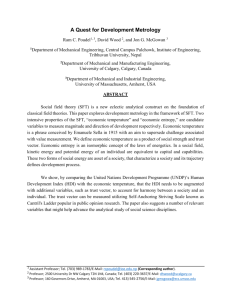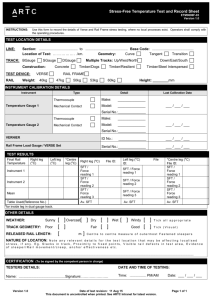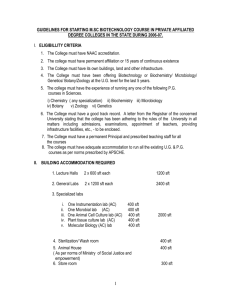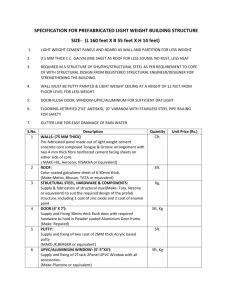Intercrossing different varieties of plants frequently produces hybrid offspring with superior vigor and increased yields, in a s and animals
advertisement
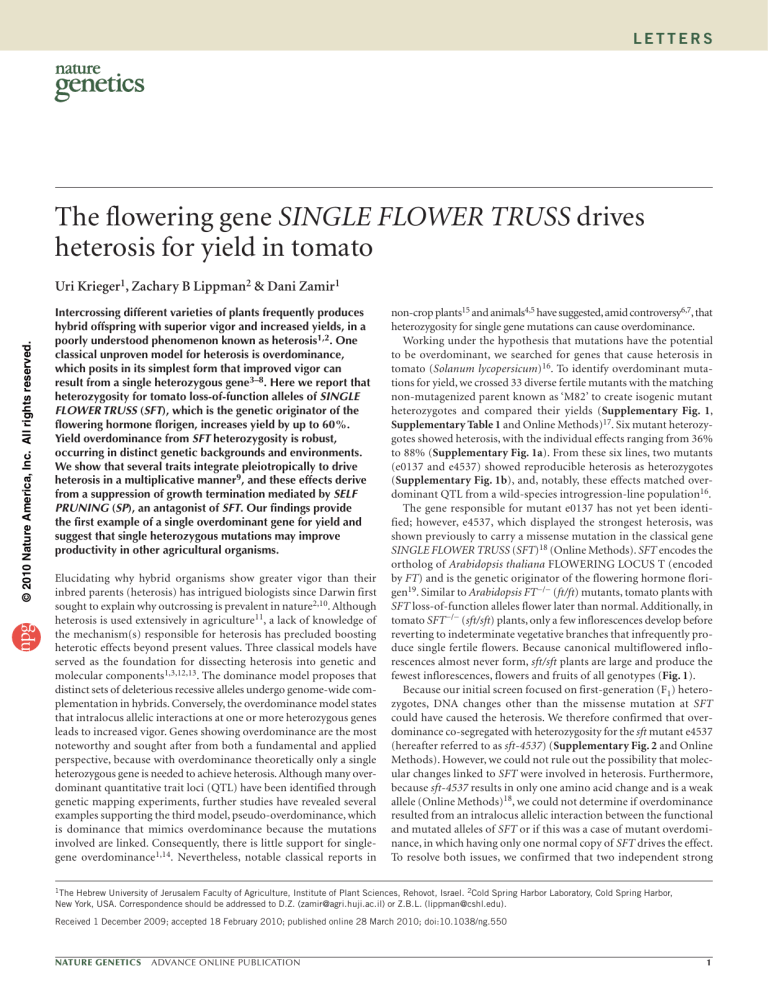
letters The flowering gene SINGLE FLOWER TRUSS drives heterosis for yield in tomato © 2010 Nature America, Inc. All rights reserved. Uri Krieger1, Zachary B Lippman2 & Dani Zamir1 Intercrossing different varieties of plants frequently produces hybrid offspring with superior vigor and increased yields, in a poorly understood phenomenon known as heterosis1,2. One classical unproven model for heterosis is overdominance, which posits in its simplest form that improved vigor can result from a single heterozygous gene3–8. Here we report that heterozygosity for tomato loss-of-function alleles of SINGLE FLOWER TRUSS (SFT), which is the genetic originator of the flowering hormone florigen, increases yield by up to 60%. Yield overdominance from SFT heterozygosity is robust, occurring in distinct genetic backgrounds and environments. We show that several traits integrate pleiotropically to drive heterosis in a multiplicative manner9, and these effects derive from a suppression of growth termination mediated by SELF PRUNING (SP), an antagonist of SFT. Our findings provide the first example of a single overdominant gene for yield and suggest that single heterozygous mutations may improve productivity in other agricultural organisms. Elucidating why hybrid organisms show greater vigor than their inbred parents (heterosis) has intrigued biologists since Darwin first sought to explain why outcrossing is prevalent in nature2,10. Although hetero­sis is used extensively in agriculture11, a lack of knowledge of the mechanism(s) responsible for heterosis has precluded boosting heterotic effects beyond present values. Three classical models have served as the foundation for dissecting heterosis into genetic and molecular components1,3,12,13. The dominance model proposes that distinct sets of deleterious recessive alleles undergo genome-wide complementation in hybrids. Conversely, the overdominance model states that intralocus allelic interactions at one or more heterozygous genes leads to increased vigor. Genes showing overdominance are the most noteworthy and sought after from both a fundamental and applied perspective, because with overdominance theoretically only a single heterozygous gene is needed to achieve heterosis. Although many overdominant quantitative trait loci (QTL) have been identified through genetic mapping experiments, further studies have revealed several examples supporting the third model, pseudo-overdominance, which is dominance that mimics overdominance because the mutations involved are linked. Consequently, there is little support for singlegene overdominance1,14. Nevertheless, notable classical reports in non-crop plants15 and animals4,5 have suggested, amid controversy6,7, that heterozygosity for single gene mutations can cause overdominance. Working under the hypothesis that mutations have the potential to be overdominant, we searched for genes that cause heterosis in tomato (Solanum lycopersicum)16. To identify overdominant mutations for yield, we crossed 33 diverse fertile mutants with the matching non-mutagenized parent known as ‘M82’ to create isogenic mutant heterozygotes and compared their yields (Supplementary Fig. 1, Supplementary Table 1 and Online Methods)17. Six mutant heterozygotes showed heterosis, with the individual effects ranging from 36% to 88% (Supplementary Fig. 1a). From these six lines, two mutants (e0137 and e4537) showed reproducible heterosis as heterozygotes (Supplementary Fig. 1b), and, notably, these effects matched overdominant QTL from a wild-species introgression-line population16. The gene responsible for mutant e0137 has not yet been identified; however, e4537, which displayed the strongest heterosis, was shown previously to carry a missense mutation in the classical gene SINGLE FLOWER TRUSS (SFT)18 (Online Methods). SFT encodes the ortholog of Arabidopsis thaliana FLOWERING LOCUS T (encoded by FT) and is the genetic originator of the flowering hormone florigen19. Similar to Arabidopsis FT−/− (ft/ft) mutants, tomato plants with SFT loss-of-function alleles flower later than normal. Additionally, in tomato SFT−/− (sft/sft) plants, only a few inflorescences develop before reverting to indeterminate vegetative branches that infrequently produce single fertile flowers. Because canonical multiflowered inflorescences almost never form, sft/sft plants are large and produce the fewest inflorescences, flowers and fruits of all genotypes (Fig. 1). Because our initial screen focused on first-generation (F1) hetero­ zygotes, DNA changes other than the missense mutation at SFT could have caused the heterosis. We therefore confirmed that overdominance co-segregated with heterozygosity for the sft mutant e4537 (hereafter referred to as sft-4537) (Supplementary Fig. 2 and Online Methods). However, we could not rule out the possibility that molec­ ular changes linked to SFT were involved in heterosis. Furthermore, because sft-4537 results in only one amino acid change and is a weak allele (Online Methods)18, we could not determine if overdominance resulted from an intralocus allelic interaction between the functional and mutated alleles of SFT or if this was a case of mutant overdominance, in which having only one normal copy of SFT drives the effect. To resolve both issues, we confirmed that two independent strong 1The Hebrew University of Jerusalem Faculty of Agriculture, Institute of Plant Sciences, Rehovot, Israel. 2Cold Spring Harbor Laboratory, Cold Spring Harbor, New York, USA. Correspondence should be addressed to D.Z. (zamir@agri.huji.ac.il) or Z.B.L. (lippman@cshl.edu). Received 1 December 2009; accepted 18 February 2010; published online 28 March 2010; doi:10.1038/ng.550 Nature Genetics ADVANCE ONLINE PUBLICATION letters b c Total fruit yield 18 16 14 12 10 8 6 4 2 0 ** ** ** ** * ** 3 2 ** 1 M 82 (c o nt ro l) sf t-4 53 7 sf t-7 18 7 sf sf t-s t-4 to 53 p 7 sf t-7 × M 82 18 7 × sf t-s M 82 to p × M AB 82 2 hy br id 0 nt ro l) sf t-4 53 7 sf t-7 18 7 s sf t-4 ft-s to 53 p 7 sf t-7 × M 82 18 7 × sf M t-s 82 to p × M AB 82 2 hy br id M 82 sft-4537 × M82 ** 4 sft-4537 Figure 1 Heterozygosity for loss-of-function mutations in SFT drives heterosis in tomato. (a) Representative plant and total fruit yield from a highyielding M82 inbred control plant (left), a low-yielding homozygous loss-of-function mutant allele of SFT (sft-4537, right; Online Methods) and a highly heterotic sft-4537/+ heterozygote (middle). All genotypes are isogenic in the M82 background. (b) Statistical comparison of mean values (± s.e.m.) for total fruit yields between three independently derived sft/sft homozygous mutants (carrying the sft-4537 weak allele, sft-7187 strong allele and sft-stop strong allele, respectively; Online Methods), the inbred M82 control and the F 1 sft/+ hybrids of the sft/sft mutants with M82. Total fruit yields from all three sft/+ heterozygotes were heterotic over M82 controls, and sft-4537/+ and sft-7187/+ heterozygotes achieved the same yields as AB2, which is a leading commercial processing-tomato hybrid. (c) Statistical comparison of mean values (± s.e.m.) for fruit sugar content (Brix value) showing an intermediate effect for sft/+ heterozygotes relative to M82 controls (low sugar) and sft/sft homozygotes (high sugar). Lines marked with asterisks are significantly different from the M82 control according to the ‘compare with control’ (Dunnett’s) method: *P < 0.05, **P < 0.01. Similar results were obtained using multiple comparison analysis (Tukey-Kramer test; **P < 0.05) for total fruit yield, which revealed a significant difference between AB2 and sft/+ heterozygotes compared to M82 plants and sft/sft homozygotes. For Brix values, all four groups of genotypes were significantly different from each other (Tukey-Kramer test; **P < 0.05). mutant alleles of SFT (sft-7187 and sft-stop) showed significant heterosis (Fig. 1b and Online Methods). These results unequivocally link sft/+ heterozygosity with heterosis and provide the first example of a single overdominant gene for yield. Furthermore, overdominance can be achieved by having only a single functional allele of a gene, as opposed to a synergistic interaction between two alleles. Heterosis in agriculture is predominantly based on full-genome hybridization between different inbred plants, and the heterotic response can vary widely depending on environment and genetic background1. The processing-tomato industry seeks varieties with both high total fruit yield and high sugar content (Brix value), but total yield is the trait that is primarily sought20. We tested the strength and consistency of sft/+ overdominance in diverse planting conditions, environments and genetic backgrounds. We observed that both sft-4537/+ and sft-7187/+ heterozygotes achieved the same yields as a leading commercial tomato hybrid (Fig. 1b and Online Methods). Furthermore, despite the typical inverse relationship between fruit yield and sugar content21, the Brix values increased in sft/+ heterozygotes relative to the M82 tomatoes, although the Brix effect was intermediate (additive: d/[a] ratios of −0.49; see Online Methods) between M82 and sft mutant plants (Fig. 1c and Online Methods), similar to plant weight (Supplementary Fig. 3). Furthermore, in seven different field-based experiments, we consistently detected significant heterosis in sft/+ heterozygotes (Supplementary Table 2). Total fruit yield was significantly (P < 0.05) overdominant in all but three instances, which involved either dense spacing or non­irrigated conditions, but the yields of sft/+ heterozygotes still exceeded those of M82 plants and their sugar production was higher, resulting in heterosis for the multiplicative phenotype of Brix-yield. Finally, we also observed strong sft/+ overdominance in crosses with two distinct genetic backgrounds (Fig. 2, Supplementary Table 3 and Online Methods). Thus, SFT-dependent heterosis is extremely robust and shows substantial potential for broad agricultural application. Figure 2 sft/+ heterozygosity causes heterosis M99 background E6203 background 1,200 900 in distinct genetic backgrounds and growth ** Wide spacing Wide spacing Dense spacing 800 ** conditions. In the tomato industry, genotypes 1,000 700 ** with high yield and Brix value (that is, high 800 600 values of Brix-yield, the multiplied output of 500 * * 600 Brix and total fruit yield measured in g/m2) are 400 the most efficient for the production of various ** 400 300 tomato concentrates. (a) Statistical comparison 200 200 of Brix-yield between sft/+ heterozygotes in the 100 background of a full-genome hybrid between 0 0 M82 and the processing-tomato line E6203 (dark gray) (Online Methods), the homozygous inbred lines M82 and E6203 (white) and the hybrid (M82 × E6203) control (light gray). Experiments were performed in both wide- and dense-spacing conditions (Online Methods). (b) Statistical comparison of Brix-yield between sft/+ heterozygotes in the background of the large-fruited fresh market tomato line M99 (dark gray) (Online Methods), the homozygous inbred lines M82 and M99 (white) and the hybrid controls (M82 × M99) (light gray). The mean values (± s.e.m.) for each genotype marked by asterisks reflect a significant difference from the control hybrids according to the ‘compare with control’ (Dunnett’s) method: *P < 0.05, **P < 0.01. Similar results were obtained using multiple-range means comparison (Tukey-Kramer test; **P < 0.05), which revealed a significant difference between sft/+ heterozygotes and their corresponding controls. a b M 99 82 × (c M on 9 tro 9 l) sf t× M 99 M 82 M 82 20 3 × (c E6 on 20 tro 3 l) sf t× E6 20 3 M 82 E6 M × (c E6 on 20 tro 3 l) sf t× E6 20 3 3 20 E6 M 82 M 82 Brix yield (g/m2) Brix yield (g/m2) © 2010 Nature America, Inc. All rights reserved. M82 ** 5 Brix ** ** 6 * ** Fruit sugar content (Brix) 7 ** (c o Total fruit yield (kg) a aDVANCE ONLINE PUBLICATION Nature Genetics letters Figure 3 SFT-dependent heterosis arises from b c 900 d 100 multiple phenotypic changes on component 120 ** 800 traits that integrate to improve yield. ** 100 * 90 700 (a) Representative inflorescences from M82 ** 600 80 plants (left), sft/sft homozygous mutants (right) 80 500 and sft/+ heterozygotes (middle). The sft/sft 60 400 70 homozygotes produce only a few inflorescences 300 40 before reverting to indeterminate vegetative 200 60 20 branches that infrequently produce single ** 100 fertile flowers, which were counted. Because 0 0 50 canonical multiflowered inflorescences almost never form, sft/sft mutant plants have the M82 sft-4537 sft-4537 x fewest inflorescences, flowers and fruits of any M82 genotype. (b–d) Quantification and statistical comparison of three component traits for yield. (b) sft/+ heterozygotes (dark gray) produce more inflorescences compared to M82 plants. As canonical inflorescences almost never form in sft/sft homozygous mutants, no data was collected for this genotype. (c) sft/+ heterozygotes produce the most flowers per plant of all genotypes (are overdominant) and show an additive effect for fruit weight (d), with a d/[a] value of 0.25. Mean values (± s.e.m.) were compared to the M82 isogenic line (white) using the ‘compare with control’ (Dunnett’s) method when three genotypes were present, and a t-test analysis was performed when two genotypes were present (total inflorescence). Significant differences compared to M82 plants are represented by asterisks: *P < 0.05, **P < 0.01. Classical tomato heterosis is driven predominantly by QTL that control reproductive traits that integrate multiplicatively 16,22. To determine the basis of sft/+ heterosis, we examined the contributions of two major component traits of yield: total number of flowers per plant (total inflorescences multiplied by flowers per inflorescence) and fruit weight (Fig. 3). Consistent with previous experiments, total fruit yield was overdominant and Brix and plant weight showed intermediate effects (data not shown). Due to the small number of non-canonical vegetative inflorescences that form in plants with the sft/sft mutation, only individual flowers scattered throughout the plant were counted (Figs. 1a and 3a). We found that both total inflorescences (Fig. 3b) and flowers per inflorescence (M82, 6.5 ± 0.32; sft/+ heterozygotes, 7.5 ± 0.21; P < 0.05) were higher in sft/+ sf t on t sf rol) t× M 82 Fruit weight (g) M 82 (c sf t on tro l sf t× ) M 82 (c M 82 heterozygotes ­compared to M82 plants, indicating that each of these traits ­contributes to overdominance of total flower number (Fig. 3c). Although plants with the sft/sft mutation produced the fewest ­flowers, they were completely fertile, indicating that low fruit yield results from low flower production. Fruit weight had an intermediate effect and was therefore also a partial contributor to sft/+ heterosis as a nonreproductive trait (Fig. 3d). Thus, similar to classical heterosis, sft/+ heterosis is based on the integration of multiple component traits, the majority of which are overdominant. Due to its prominent role in flower number and total fruit yield, increased inflorescence production was the most likely impetus behind sft/+ heterosis. To understand how increased numbers of inflorescences form, we quantified their accumulation over time throughout a b Figure 4 Overdominance for inflorescence sft mutant –/– –/– sft heterozygote (sft , sp ) production is based on a dosage-dependent Inflorescence production –/+ –/– (sft , sp ) vegetative inflorescence 120 suppression of growth termination mediated by sft × M82 7–8 inflorescences/shoot * Terminal M82 100 SP. (a) Temporal accumulation of inflorescences Determinate * inflor. +/+ –/– (SFT , sp ) 2 in M82 plants (red) and sft/+ heterozygotes 80 Vegetative 5–6 inflorescences/shoot 1 (gray) throughout growth. Significant differences inflor. 60 1 Terminal 2 between mean values were calculated in each inflor. 40 1 1 Suppressed time point using t-test analyses and are 2 ** 2 sympodial unit 20 represented by asterisks: *P < 0.05, **P < 0.01. 3 0 3 (b) Diagrams showing the reiteration of modular 12–16 8 10 13 17 leaves sympodial units along individual shoots from 7–9 weeks weeks weeks weeks 7–9 leaves M82-determinate (left), sft/sft homozygote leaves Indeterminate +/+ +/+ (right) and sft/+ heterozygote plants (middle). (SFT , SP ) Numbers indicate total number of leaves in each 16 Sympodial (12.6 kg) shoot 14 sympodial unit, which are indicated by brackets. (11.1 kg) reiteration 12 3 Flattened gray and black ovals indicate sets 10 SFT of leaves in alternating sympodial units. Black 8 3 (leaves) and gray arrows represent axillary shoots 6 EXP 3 4 preceding the inflorescence in each sympodial (leaves) 2 unit. Note that there are more sympodial 3 0 SI-AP1 units, inflorescences and leaves along each (apex) 7–9 shoot of sft/+ heterozygotes compared to EXP leaves M82-determinate and sft/sft mutant plants (apex) (Supplementary Fig. 4). (c) Diagram of a shoot from an M82-indeterminate plant (left) and a yield comparison between sft/+ heterozygotes in an indeterminate background (sft/+, sp/+) and control M82-indeterminate plants (sft/+, sp/+). Total fruit yields of M82-determinate × M82-indeterminate (light gray) and sft/sft × M82-indeterminate (dark gray) do not differ significantly from each other, and both are lower yielding than the heterotic sft/+ M82-determinate plants, which are the highest yielding of all genotypes (Supplementary Fig. 5). (d) RT-PCR analysis of SFT and Sl-AP1 expression levels in young expanding leaves and shoot apices, respectively, showing no qualitative differences in transcript accumulation between M82 plants and heterozygote genotypes for either gene. EXP (EXPRESSED, SGN-U346908) is a published gene showing stable expression across diverse tissues, used here as real-time PCR control (Online Methods). Inflorescence number 82 M × H 2 0 7 7 18 18 t-7 sf t-7 sf 7 53 53 t-4 t-4 82 sf sf M 7 × er dd la -ID 82 M sf t× 82 -D × M 82 -ID D N A Total fruit yield (kg) d M 82 c M © 2010 Nature America, Inc. All rights reserved. M 82 (c on tro l sf t× ) M 82 Total flowers per plant Total canonical inflorescences a Nature Genetics ADVANCE ONLINE PUBLICATION © 2010 Nature America, Inc. All rights reserved. letters a growing season (Fig. 4a). Whereas M82 plants had slightly more inflorescences than sft/+ heterozygotes at 8 weeks, their inflorescence production slowed by 13 weeks and plateaued at 17 weeks, a few weeks before harvesting. In contrast, sft/+ heterozygote inflorescences accumulated linearly up through 13 weeks and production only began to plateau at 17 weeks, indicating that sft/+ heterozygotes develop more inflorescences in a shorter time. Given that the normal function of SFT is to promote flowering, we reasoned that sft/+ heterozygote heterosis might be based on a shift in the balance of vegetative to reproductive growth. Tomato plants form inflorescences and flowers within a compound sympodial shoot system, which is defined by the continuous cycling of growth termi­nation and renewal23. In a typical plant, all growth arises from the reiteration of modular sympodial units that each produce three leaves and a multiflowered inflorescence23,24 (Fig. 4). All field-grown varieties of tomato, including M82, are determinate (D) plants whose shoots produce an average of six sympodial units, each harboring a single inflorescence, within which leaf number gradually decreases before a precocious termination of growth owing to a mutation in SP—an ortholog of TERMINAL FLOWER1 (TFL1) and a member of the SFT/FT gene family23 (Fig. 4b). In sft/+ heterozygotes, we found a greater number of inflorescences and leaves on all shoots than in M82 plants (Supplementary Fig. 4). Further, more sympodial units developed on the sft/+ heterozygotes, and each sympodial unit harbored a variable number of leaves ranging from 1 to 3 (Fig. 4b). Thus, sft/+ heterozygosity transforms the way sympodial units are reiterated and structured in determinate plants. These observations suggest that sft/+ heterosis might be based on having only one fully functional copy of SFT, causing a dosage-dependent suppression of growth termination imposed by SP. We tested this hypothesis by crossing plants with the sft mutation to M82-indeterminate (ID) plants carrying a functional SP gene, and in all cases, heterosis was eliminated (Fig. 4c and Supplementary Fig. 5). The relationship of sft/+ heterozygosity to an SP background also highlights a role for epistasis in heterosis. With such pronounced phenotypic consequences, it might be expected that sft/+ overdominance results from large transcriptional changes at SFT or its primary floral targets; however, a subtle change in gene dosage predicts relatively minor transcriptional changes of no greater than 2–3-fold25. After examining SFT expression, we observed no qualitative changes (Fig. 4d, Supplementary Table 4 and Online Methods), and we detected a minor quantitative increase (twofold or less) for all SFT homozygote and heterozygote genotypes relative to M82 plants (Supplementary Fig. 6). This weak change is consistent with a dosage-dependent mechanism. We also examined expression in inflorescence shoot apices for the tomato homolog of APETALA1 (Sl-AP1), which is a direct target of SFT/FT26. Consistent with the SFT phenotype (Figs. 1a and 3a), Sl-AP1 expression was strongly reduced in plants homozygous for the sft mutation but not in those heterozygous for it. Thus, sft/+ heterosis is not caused by substantial transcriptional changes of SFT or its primary target. It has been suggested that heterosis might result from the tuned activities of dosage-dependent regulatory systems controlling signaling cascades and transcriptional networks27. Our results provide a notable example of single-gene overdominance for tomato yield and offer empirical evidence that, rather than being caused by allelic interactions, subtle changes in gene dosage can lead to overdominance. In our case, overdominance depends on opposing flowering signals from SFT and SP, a relationship that has been proposed to be critical for overall plant growth19. We hypothesize that sft/+ heterosis is based on the altered dosage of functional SFT protein within each modular sympodial unit. Due to the dynamic nature of the reproductive transition in the stem cell populations, where opposing activities of SFT and SP operate, a shift in the reproductive transition due to sft/+ heterozygosity would be transient and difficult to capture molecularly. This is because as one sympodial unit transitions, a new SFT-SP balance is established in the subsequent unit. We predict that sympodial units are particularly sensitive to the altered dosage of SFT in plants homozygous for the sp mutation, which would explain the dramatic pleiotropic changes for the entire plant if sft/+ heterozygosity quantitatively suppresses multiple sp-induced termination events, thereby allowing more units to develop. Such a mechanism could explain heterosis in other field tomatoes, which are all in the homozygous sp mutant background. It is also conceivable that the impact of sft/+ heterozygosity on determinate growth might exemplify a more widespread mechanism in which altering the dosage of any genes controlling growth determinacy through mutant heterozygosity can explain or lead to heterosis in other species. Notably, our data suggest that any case of heterosis involving deleterious recessive mutations can be based on altered gene dosage. In this regard, it is worth noting that all crops underwent selection for multiple mutations during domestication28. Indeed, although there has been renewed support for the idea that dominance complementation explains classical heterosis in maize29 and there is evidence that epistasis plays a role in rice heterosis30, overdominance from mutant heterozygosity involving many loci with small effects on component traits could also be a principal mechanism31. This is consistent with the observation that copy number variation, often in the form of insertions and/or deletions (indels) that span genes, is widespread among inbred maize lines32. By extension, new mutations arising in nature, which are inevitably heterozygous, could show overdominance and be relevant in the short term for natural selection and over a longer time frame for population genetics2. Finally, our findings reveal a new and simple methodology to identify genes with the potential to cause agricultural heterosis. That our original screen revealed a noteworthy percentage of putative overdominant mutants suggests that heterosis through mutant heterozygosity might be a general phenomenon for plants and other organisms33,34. Screening large sets of heterozygous mutants in other model and crop species could yield additional examples of single-gene heterosis and provide innovative germplasm for plant breeding. Methods Methods and any associated references are available in the online ­version of the paper at http://www.nature.com/naturegenetics/. Accession codes. The sequences of SFT and SP have been deposited in the NCBI nucleotide database under accession codes AY186735 and LEU84140, respectively. Note: Supplementary information is available on the Nature Genetics website. Acknowledgments We thank D. Jackson, R. Martienssen, Y. Semel, Y. Eshed and members of the Lippman laboratory for comments and discussion. We also thank the researchers and field crew at the Western Galilee experimental station in Akko, Israel, Kibbutz Kfar Masaryk, Israel and Cornell University’s Long Island Horticultural Research and Extension Center in Riverhead, New York. This research was supported by individual grants from the European Commission EU-SOL Project and The Israel Science Foundation (ISF) to D.Z. and from a Heterosis Challenge Grant DBI-0922442 from the United States National Science Foundation Plant Genome Research Program to Z.B.L. AUTHOR CONTRIBUTIONS U.K., Z.B.L. and D.Z. planned and carried out all experiments, collected the data, performed the statistical analyses and wrote the paper. aDVANCE ONLINE PUBLICATION Nature Genetics letters COMPETING FINANCIAL INTERESTS The authors declare competing financial interests: details accompany the full-text HTML version of the paper at http://www.nature.com/naturegenetics/. © 2010 Nature America, Inc. All rights reserved. Published online at http://www.nature.com/naturegenetics/. Reprints and permissions information is available online at http://npg.nature.com/ reprintsandpermissions/. 1. Lippman, Z.B. & Zamir, D. Heterosis: revisiting the magic. Trends Genet. 23, 60–66 (2007). 2. Crow, J.F. Mid-century controversies in population genetics. Annu. Rev. Genet. 42, 1–16 (2008). 3. Shull, G.H. The composition of a field of maize. Am Breed Associ 4, 296–301 (1908). 4. Wallace, B. The effect of heterozygosity for new mutations on viability in Drosophila: a preliminary report. Proc. Natl. Acad. Sci. USA 43, 404–407 (1957). 5. Wallace, B. The role of heterozygosity in Drosophila populations. Proc. 10th Intern. Cong. Genet. 1, 408–419 (1959). 6. Muller, H.J. & Falk, R. Are induced mutations in Drosophila overdominant? I. Experimental Design. Genetics 46, 727–735 (1961). 7. Muller, H.J. & Falk, R. Are induced mutations in Drosophila overdominant? II. Experimental Results. Genetics 46, 737–757 (1961). 8. Schwarz, D. Single gene heterosis for alcohol dehydrogenase in maize: the nature of the subunit interaction. Theor. Appl. Genet. 43, 117–120 (1973). 9. Williams, W. Heterosis and the genetics of complex characters. Nature 184, 527–530 (1959). 10. Darwin, C.E. The Effects of Cross- and Self-Fertilization in the Vegetable Kingdom (John Murray, London, 1876). 11. Duvick, D.N. Heterosis: feeding people and protecting natural resources. in The Genetics and Exploitation of Heterosis in Crops (eds. Coors, J.G. & Pandey, S.) 19–29 (ASSA, CSSA, SSSA, Madison, 1999). 12. Crow, J.F. Dominance and overdominance. in Heterosis 282–297 (Iowa State College Press, Ames, Iowa, USA, 1952). 13. Birchler, J.A., Auger, D.L. & Riddle, N.C. In search of the molecular basis of heterosis. Plant Cell 15, 2236–2239 (2003). 14. Charlesworth, D. & Willis, J.H. The genetics of inbreeding depression. Nat. Rev. Genet. 10, 783–796 (2009). 15. Redei, G.P. Single locus heterosis. Z. Vererbungsl. 93, 164–170 (1962). 16. Semel, Y. et al. Overdominant quantitative trait loci for yield and fitness in tomato. Proc. Natl. Acad. Sci. USA 103, 12981–12986 (2006). Nature Genetics ADVANCE ONLINE PUBLICATION 17. Menda, N., Semel, Y., Peled, D., Eshed, Y. & Zamir, D. In silico screening of a saturated mutation library of tomato. Plant J. 38, 861–872 (2004). 18. Lifschitz, E. et al. The tomato FT ortholog triggers systemic signals that regulate growth and flowering and substitute for diverse environmental stimuli. Proc. Natl. Acad. Sci. USA 103, 6398–6403 (2006). 19. Shalit, A. et al. The flowering hormone florigen functions as a general systemic regulator of growth and termination. Proc. Natl. Acad. Sci. USA 106, 8392–8397 (2009). 20. Gur, A. & Zamir, D. Unused natural variation can lift yield barriers in plant breeding. PLoS Biol. 2, e245 (2004). 21. Schauer, N. et al. Comprehensive metabolic profiling and phenotyping of interspecific introgression lines for tomato improvement. Nat. Biotechnol. 24, 447–454 (2006). 22. Whaley, W.G. A developmental analysis of heterosis in Lycopersicon I. The relation of growth rate to heterosis. Am. J. Bot. 26, 609–616 (1939). 23. Pnueli, L. et al. The SELF-PRUNING gene of tomato regulates vegetative to reproductive switching of sympodial meristems and is the ortholog of CEN and TFL1. Development 125, 1979–1989 (1998). 24. Lippman, Z.B. et al. The making of a compound inflorescence in tomato and related nightshades. PLoS Biol. 6, e288 (2008). 25. Veitia, R.A., Bottani, S. & Birchler, J.A. Cellular reactions to gene dosage imbalance: genomic, transcriptomic and proteomic effects. Trends Genet. 24, 390–397 (2008). 26. Kobayashi, Y. & Weigel, D. Move on up, it’s time for change–mobile signals controlling photoperiod-dependent flowering. Genes Dev. 21, 2371–2384 (2007). 27. Birchler, J.A., Yao, H. & Chudalayandi, S. Biological consequences of dosage dependent gene regulatory systems. Biochim. Biophys. Acta 1769, 422–428 (2007). 28. Doebley, J.F., Gaut, B.S. & Smith, B.D. The molecular genetics of crop domestication. Cell 127, 1309–1321 (2006). 29. McMullen, M.D. et al. Genetic properties of the maize nested association mapping population. Science 325, 737–740 (2009). 30. Yu, S.B. et al. Importance of epistasis as the genetic basis of heterosis in an elite rice hybrid. Proc. Natl. Acad. Sci. USA 94, 9226–9231 (1997). 31. Flint-Garcia, S.A., Buckler, E.S., Tiffin, P., Ersoz, E. & Springer, N.M. Heterosis is prevalent for multiple traits in diverse maize germplasm. PLoS One 4, e7433 (2009). 32. Belo, A. et al. Allelic genome structural variations in maize detected by array comparative genome hybridization. Theor. Appl. Genet. 120, 355–357 (2009). 33. Gemmell, N.J. & Slate, J. Heterozygote advantage for fecundity. PLoS One 1, e125 (2006). 34. Delneri, D. et al. Identification and characterization of high-flux-control genes of yeast through competition analyses in continuous cultures. Nat. Genet. 40, 113–117 (2008). © 2010 Nature America, Inc. All rights reserved. ONLINE METHODS Plant material and genotyping. Thirty-three homozygous mutants were selected from a mutant library in the processing-tomato cultivar M82, which is determinate due to homozygosity for a mutation in the SP gene (see URLs)17 (Supplementary Table 1). Screening focused on fertile mutants that had various defects in developmental traits and overall growth, which were tested by progeny test for single-gene segregation. Individual mutant descriptions were based on a large phenotypic screen for mutants within ~16,000 independent M2-generation families categorized into primary and subphenotypic categories17. These phenotypic categories were general for the purpose of the database, and more detailed study on some of the mutants has resulted in more precise phenotypic descriptions. For example, the descriptor ‘partial sterility’ is used to describe the sft mutation, but this refers to the observation that few flowers and fruits are produced in plants homozygous for this mutation, as opposed to flower sterility or fruit set. Seven mutants of known loci were chosen (Supplementary Table 1), and for two of them, two alleles were selected and plants bearing the different alleles were counted as independent lines (LATERAL SUPPRESSOR (LAS), e0064m2 and e9148m2; ENTIRE (EN), e2986m1 and e3335m1). This is because it could not be assumed that all mutant alleles for a particular gene would result in the same phenotypic response. All mutants were crossed as males to M82 plants. The alleles sft-4537 and sft-7187 tested in 2009 derive from the original M82 mutant library and have been described as weak (sft-4537) and strong (sft-7187) late-flowering mutants due to DNA mutations in the flowering gene SFT18. The mutation in sft-4537 is a single-base-pair change at nucleotide position 194 (C to T) that results in a single-amino-acid change from threonine to isoleucine. The mutation in sft-7187 is a two-base-pair deletion at positions 466 through 467 that causes a frameshift and a presumed truncated C terminus of the SFT protein. The sft-stop allele was discovered separately in the M82 background and verified to be a new mutant allele in SFT by complementation tests with both sft-4537 and sft-7187. Subsequent sequencing revealed a single-base-pair change at position 148 (C to T) that introduces a nonsense mutation (stop codon) and truncates the last two-thirds of the SFT protein. Both sft-7187 and sft-stop are considered strong alleles relative to sft-4537 based on their lateflowering effects and highly vegetative inflorescences, and sft-stop is likely a null allele. Homozygous sft-4537 and sft-7187 mutations backcrossed at least three times into the M82 background were gifts from Y. Eshed (Weizmann Institute of Science, Rehovot, Israel). Progeny tests and PCR-based genotyping markers were used to identify plants heterozygous for sft-stop after backcrossing to M82 at least twice to eliminate other mutations. The F2-generation segregating population of sft-4537 was obtained by self-fertilization of heterozygous plants. To simplify our phenotypic analysis and experimental design, PCR-based genotyping markers were developed for all SFT mutant alleles (Supplementary Table 4). Based on their similar heterozygous phenotypic effects, only sft-4537 and sft-7187 alleles were used as inbred parents to generate full-genome heterozygotes with the inbred genetic backgrounds E6203 and M99. Like M82, E6203 is an inbred processing-tomato variety that serves as a common experimental inbred line and has been used extensively in research35. M99 was developed in our lab and is a large-fruited fresh market tomato inbred line. AB2 is a leading processing-tomato commercial hybrid from the AB Seed Company. Indeterminate lines containing two functional alleles of the SP gene were M82ID, M83, rin and Alisa Craig, and crosses with these were performed with sft-4537 and sft-7187 serving as male parents. Field trials. Field trials were conducted during the years 2008 and 2009. Experiments were performed at the Western Galilee experimental station in Akko, Israel; in Kfar Masaryk, Israel; and at the Cornell horticultural experiment station in Riverhead, New York. Seedlings were grown in a commercial nursery for 35–40 d and transplanted to the field at the beginning of April. The Akko experiments were conducted under wide (1 plant per m2) and dense (2.5 plants per m2) spacing using two irrigation regimes. In the nonirrigated treatments, 60 m3 of water per 1,000 m2 were applied immediately after transplanting, whereas 300 m3 of water per 1,000 m2 were applied in the irrigated treatments during the season according to drip irrigation protocols standard for the area. Given their low fertility and extreme plant size, sft/sft homozygous mutants for all three alleles were tested in isolation in a block neighboring other experiments. To test for consistency of sft/+ heterosis, Nature Genetics selected ­experiments were repeated using both replicated single plant experiments or replicated individual plots of ten plants in 4 m2 under commercial field and diverse agricultural conditions at Kfar Masaryk, Israel, and in the United States. Each genotype in the single-plant experiments was represented by a minimum of 15 replicates, and in some experiments 60 replicates were used. Twelve replicates for each genotype were used in the plot experiments. As few as five replicates were used to represent homozygous sft/sft mutants due to their consistently low yields and large plant stature. All plants were transplanted in a completely randomized design. Experiments involving indeterminate lines were transplanted both to the field and to greenhouses and treated according to commercial cultivation protocols. Phenotypic evaluations and statistical analyses. Harvests were conducted when all plants in a trial had 80% or more red fruit. For each individual plant in the wide-spacing experiments, phenotypic measurements of plant weight and total fruit yield were taken after plants were manually removed from the soil, along with ten random fruits from which to estimate the average fruit weight and total soluble solids content (mainly sugars), the latter referred to as Brix value and measured by a digital Brix refractometer (ATAGO Palette PR-32α). For the dense-spacing experiments, total fruit yield was measured on plots 4 m2, and 20 random fruits were used to estimate fruit weight and Brix. All statistical calculations were performed using the JMP 7.0.1 software package (SAS Institute). Mean values for each measured yield parameter were analyzed using the “Fit Y by X” function and statistically compared using a Tukey-Kramer multiple comparison test, Dunnett’s ‘compare with control’ test, or t-test, whenever appropriate. The degree of dominance for each trait was calculated using the d/[a] equation, where the additive effect (a) was half of the difference between the SFT mutant and M82; the dominance deviation (d) was the difference between sft/+ heterozygotes and the mid value of its parents; and the degree of dominance for each SFT mutant allele (d/[a]) was calculated by dividing the mean dominance deviation by the absolute mean additive effect. Measurements of plant structure and yield component traits were taken from four equivalent trials at 8, 10, 13 and 17 weeks after planting to capture all major developmental changes. At each time point, individual replicate plants were dissected for selected component traits for yield (plant weight, total fruit yield, Brix value, fruit weight, inflorescence number and flowers per inflorescence). Inflorescences were considered only after one or more fruits had set on a truss. Total organ number per shoot was evaluated from five plants per genotype, each presented by four or more shoots that contained more than three inflorescences to provide a minimum of 20 replicates for each genotype. Data availability. All raw data for the heterosis field trials are available to analyze and download from the site for Phenom Networks (see URLs), which is a web-based platform for complex phenotype analysis in plant breeding. Expression analysis (RT-PCR). Three biological replicates per genotype were extracted from leaves (the third-oldest leaf was used) and apices of 4-week-old seedlings grown in a greenhouse (eight representative plants in each sample). Total RNA was extracted using Trizol (Invitrogen) and treated with DNase (Promega) according to the manufacturer’s protocol. Reverse transcription was performed using 1 µg of total RNA with the SuperScript First-Strand Synthesis System for RT-PCR (Invitrogen). Qualitative RT-PCR was performed for SFT and Sl-AP1 (Supplementary Table 4), and PCR was carried out at three different total cycle numbers (24, 28 and 32) for each gene using the third uppermost expanding leaf 4–5 cm in length (SFT) and inflorescence apices carrying the first flower and first sympodial unit and inflorescence meristem (AP1). Agarose gels (3%) were run for each cycle, and analysis was performed using the cycle number that approximated the linear phase of amplification based on the increase in band intensity. To achieve a quantitative estimation of transcript abundance, real-time quantitative RT-PCR reactions were performed using the SuperScript III First-Strand Synthesis SuperMix followed by Power SYBR Green PCR Master Mix (Invitrogen). At least two biological replicates for each genotype and each gene were analyzed in three technical triplicates using a Bio-Rad/MJ Chromo4 real-time PCR machine, and each data point was calculated from the Opticon program and analyzed as the average of the three biological replicates at the beginning of the linear ­amplification doi:10.1038/ng.550 phase. Quantification was based on the number of PCR cycles (Ct) required to cross a threshold of fluorescence intensity and was compared to a previously published real-time PCR control gene showing stable expression across diverse tissues36 (EXP (EXPRESSED), SGN-U346908) using the 2−∆∆Ct technique. 35. Doganlar, S., Frary, A., Ku, H.M. & Tanksley, S.D. Mapping quantitative trait loci in inbred backcross lines of Lycopersicon pimpinellifolium (LA1589). Genome 45, 1189–1202 (2002). 36. Expósito-Rodríguez, M., Borges, A.A., Borges-Perez, A. & Perez, J.A. Selection of internal control genes for quantitative real-time RT-PCR studies during tomato development process. BMC Plant Biol. 8, 131 (2008). © 2010 Nature America, Inc. All rights reserved. URLs. Tomato mutant library, http://zamir.sgn.cornell.edu/mutants; Phenom Networks, http://phnserver.phenome-networks.com/icis/. All raw data, and a PowerPoint explanatory demonstration for statistical analysis for the heterosis field trials, are available to analyze and download from Phenom Networks (http://phnserver.phenome-networks.com/icis/), and the data are freely available on the World Wide Web. doi:10.1038/ng.550 Nature Genetics

